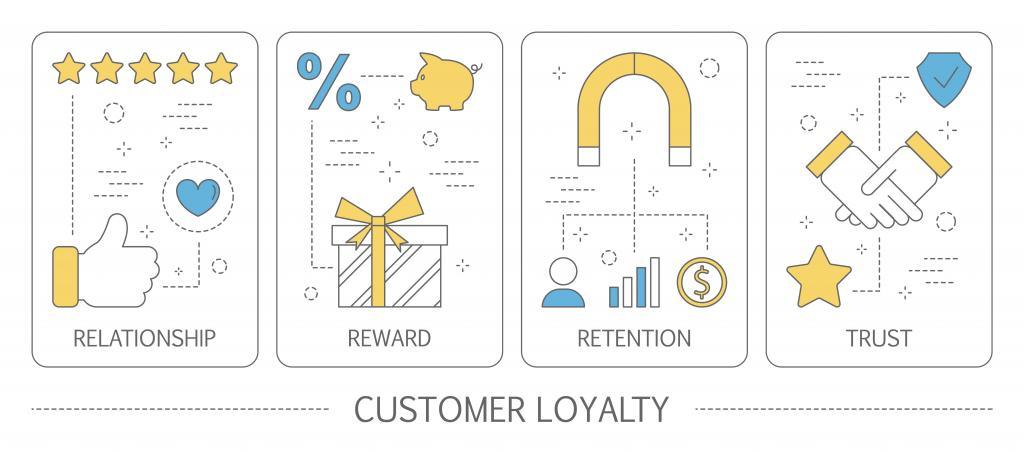
What Customer Loyalty Is, Why It Is Important, And How Commbox’s Omni-Channel Customer Service Platform Facilitates Business Success
It is becoming increasingly difficult to build customer loyalty, with as many as 60% of buyers now actively taking steps to switch brands even when satisfied by purchases.
Increased market transparency in the age of online shopping has decreased many consumers’ natural tendency towards loyalty, making customer retention less secure even for brands with positive reputations. Customers’ service expectations also change rapidly with the advent of new customer service technologies and the introduction of new sales and communication platforms. This has made customer satisfaction a moving target for firms trying to develop customer loyalty. Moreover, it has dramatically increased the chances that a firm will lose its customers’ loyalty, as up to 75% of consumers will not complete their order with or re-patronize a business if they have had a frustrating customer service experience, regardless of product satisfaction.
Organizations that adopt an omni-channel customer service platform, like CommBox, improve their ability to rapidly adapt to customers’ changing expectations. Consequently, they ultimately retain almost three times more loyal customers than non-omni-channel businesses.
What Is Customer Loyalty?
“Customer loyalty” refers to a buyer’s willingness to make repeat purchases from a business. The percentage of purchases made by repeat customers, and also the percentage of customers that go on to purchase competing goods/services after buying from a specific company, illustrate customer loyalty.
Loyal customers consistently choose to purchase a specific product — or from the product offerings of a particular brand — rather than buying from another business. These customers do not base their purchasing decisions on convenience/proximity, price, or the limited availability of alternate options.
Instead, loyal customers’ repurchasing decisions are the result of their perception of the brand independent of its competitors. Customers most often base their judgment on brand reputation and the consistency/accessibility of a firm’s promotional activities, as well as their interactions and experiences with the brand and its representatives. Consequently, loyal customers are also more likely to recommend a brand or perceive it as an industry leader and/or expert.
Conversely, disloyal customers make purchasing decisions because of price competition or the convenience/proximity of purchasing opportunities. Disloyal customers may be aware of a brand’s reputation or have had positive interactions with its representatives. However, they are still unlikely to make a repeat purchase if presented with other options that are more convenient or appear to offer better value per dollar.
Why Is Customer Loyalty Important To Business Success?
Customer loyalty increases positive social proof
Loyal customers decrease a firm’s marketing and customer acquisition costs by reviewing products/services. They do so about three times more often than disloyal customers. Their positive reviews are the most effective form of marketing available and increase brand authority. Consequently, as the brand becomes established as an industry leader and/or expert, its customer acquisition costs decrease.
Loyal customers contribute more revenue
Increasing customer retention by 5% increases revenue by 45%-95%. Repeat customers spend 35% more per purchase than first-time customers, and up to ten times more than one-time purchasers in lifetime spend. What’s more, when businesses cultivate a moderate degree of customer loyalty, repeat customers generate 40% of revenues despite accounting for 8% of the customer population.
Loyal customers cost less to convert
For average-loyalty firms, new customers convert at a rate of 1%-3% while the conversion rate of repeat customers is 60%-70%. This is significant because it costs a firm between five and twenty-five times more to acquire a new customer (that is, to attract them to the site/store then nurture them through the sales funnel to purchase) than it does to retain a repeat customer.
Consequently, firms with a large proportion of returning customers spend less on customer acquisition to achieve the same number of sales as their lower-loyalty peers. This savings is evident both in a firm’s direct advertising budget and the allocation of its labor force to other more financially impactful tasks.
How Using An Omnichannel Customer Service Approach Makes Customer Retention Easier
Customer experience reputation is now so critical to customer loyalty and retention that more than two-thirds of companies compete on the basis of customer service, while 80% expect to be competing based on customer service by the end of 2020. At that point, customer service sufficiency will overtake both price and product quality and characteristics as the most critical brand differentiator and the most significant determinant of customer loyalty.
The most significant threat to customer retention is insufficient customer service. Though poor quality is a type of insufficiency, insufficient customer service is any service that fails to meet customers’ expectations even if it ultimately meets their demands. Sources of customer service insufficiency include a lack of accessibility and/or connectivity across platforms, slower-than-desirable response times, a lack of personalization, and inconsistency in customer service agents’ responses..
Omnichannel customer service makes customer retention easier because it makes it easier for firms to meet customers’ unique and changing expectations. This increases customer satisfaction and improves the brand’s customer experience reputation.

5 Strategies For Building Customer Loyalty Using An Omnichannel Approach To Customer Service
1. Upgrade and/or restructure customer service technology & CSA responsibilities – An omni-channel customer service approach requires all-platform/cross-platform access to service channels. As a result, it meets customers’ expectations for easily-accessible customer service via every preferred contact platform, device, or method.
The most efficient strategy for achieving this kind of robust omni-channel ability is to implement a full-service omni-channel customer service management platform, like Commbox. This kind of upgrade also empowers firms to meet customers’ expectations for instant and almost-instant CSA responses.
To successfully implement this kind of system, firms must also redistribute CSAs so that their strengths align with different service streams created by the platform.
2. Integrate effective automated chatbot and procedurally-generated service update features – Automation is a critical part of omni-channel-based customer retention. But it is also one of the most difficult. This is because many chatbot apps provide relatively weak customization for automated response and redirection systems.
When implemented appropriately, automation has the proven outcome of enhancing customer service across three of the key drivers of customer satisfaction: response time, resolve time, and status updates. Both chatbots and auto-updates have an almost-immediate positive impact on customer satisfaction by increasing both the speed of service and the transparency of the service process by providing customers with updates about the progress of their inquiry.
3. Centralize record of individual customers’ service journey – After long wait times to service, the most significant source of service insufficiency comes from a lack of memory in service inquiries. Poorly implemented (or poorly designed) omni-channel customer service systems replicate the same problems of single- and standard multi-channel approaches.
Namely, different service channels provide the customer with different answers to the same inquiry. Additionally, a decentralized or difficult-to-access conversation history means the customer must repeatedly re-explain their inquiry whenever a new CSA enters the conversation. The best strategy to remedy this inefficiency is to maintain centralized knowledge banks, procedurally generated action plans, and a centrally-located easy-to-access conversation history.
4. Incorporate self-service as a form of customer service – An often-overlooked customer service channel is customer self-service. Consequently, the best omni-channel customer service strategy involves creating and maintaining easily-accessible and fully searchable self-service portals, knowledge-bases, and online preferences/account tools and empowering customers to use them.
This is essential because more than 80% of customers attempt to troubleshoot or otherwise locate or develop solutions for their issues before engaging formal customer service channels. Should a firm’s omni-channel customer support strategy fail to consider the customer self-service channel, the majority of customers (53%) will still abandon a purchase due to insufficient service without ever contacting support staff.
5. Prioritize gaining direct-from-customer insights about the service sufficiency and practice continuously responsive service design – Collecting and using customer feedback is essential to sufficient customer service. Presently, 50% of customers believe that their feedback is not used to improve service sufficiency. Consequently, only 1 in 26 dissatisfied customers actually communicates their dissatisfaction to a company; the vast majority of dissatisfied customers convert to being disloyal customers, and simply do not return to the firm.
Consequently, the best omni-channel customer support systems collect feedback at critical points in the service process, make it visible to all involved actors in the inquiry, and facilitate rapid readjustment of the service process in response to negative feedback.

How commbox omni-channel customer service improves customer loyalty
1. Makes business stand out – Presently, 97% of companies claim to have already or be in the process of implementing omni-channel customer service practices. What’s more, almost one-quarter of those companies believe that they are already providing sufficient customer service via their chosen omni-channel implementation strategies.
However, in practice, fewer than 1% of businesses are actually implementing omni-channel customer support services. This suggests that there is significant potential for misapplication of non-omni-channel services and acute misrepresentation of businesses’ service capabilities. Consequently, Commbox’s true omni-channel customer service helps companies to stand out by having a demonstrably positive impact on customer experience satisfaction and associated retention.
2. Consistently increases customer satisfaction – The true application of an omni-channel customer service platform, like Commbox, has a proven ability to rapidly increase customer satisfaction. In some cases, the implementation of a robust omni-channel customer service platform can yield a surge in customer satisfaction (up to 80%-90&) in as little as 12 weeks of use. That said, almost one-third of customers will stop buying from a brand they love following just one insufficient customer service experience. Consequently, because Commbox prioritizes consistency in customer service experience, it helps businesses navigate the very specific threat of contemporary customers’ no-strikes attitude toward insufficient service.
3. Builds customers’ trust in a business – Customers that are unwilling to trust a company are highly likely to be disloyal. Specifically, 45% of customers stop doing business with a company when they lose trust in the brand. Customer satisfaction may be the primary antecedent to the development of trust in most financial customer-business relationships. A 10% increase in customer satisfaction yields a 12% increase in customer trust in the business. Moreover, 90% of customers who feel a high level of trust for a brand are highly likely to leave positive reviews, and 70% are likely to leave detailed positive public feedback.
4. Increases CSA job satisfaction – 37% of firms find it challenging to answer repetitive or common customer service questions efficiently. Consequently, CSAs end up spending the majority of their time in phone calls with customers whose problems could have been more quickly resolved via adequate automation.
Implementing Commbox improves CSA productivity and job satisfaction by increasing the usability of chat-based service channels and funneling routine inquiries to AI-driven automated systems. As a result, customer retention increases as satisfied, well-utilized CSAs increase their service capacity per hour (decreasing wait times). Additionally, Commbox enables the creation of CSA-specific channels based on their strengths.
Why Commbox is essential to business success
Firms that do not implement appropriate tools for improving customer service/experience satisfaction are unlikely to succeed as the current trends towards service experience-based differentiation continue. Companies implementing a strong, true omni-channel customer service strategy are much more likely to retain customers than other, non-omni-channel or weak omni-channel businesses. Specifically, the effective implementation of a true omni-channel customer service platform, like Commbox, yields up to90% customer retention versus just 33% customer retention for other firms.
Given the pace at which the current consumer market is trending towards low-loyalty, low-retention customer relationships, businesses hoping to become or remain successful cannot afford to wait to implement an omni-channel customer service platform. Find out more about the CommBox omni-channel platform today!